Ultra Small Type A Submarines (Japan)
Big Torpedo Project
The author of the idea of building ultra-small submarines was the captain of 1 Kaneji Kimimoto rank. Back in 1932, he suggested using "big torpedoes with people on board." Such a technique, in his opinion, could be built in large quantities and massively used in various operations. It was assumed that from a large number of ultra-small submarines, at least several will be able to break through the enemy defenses and accomplish their combat mission - to attack ships or coastal targets. The carriers of such equipment, according to Kisimoto, were to be specially converted ships or submarines with the necessary characteristics. The presence of only four carrier ships with a dozen "big torpedoes", in his opinion, could ensure victory in any naval battle.
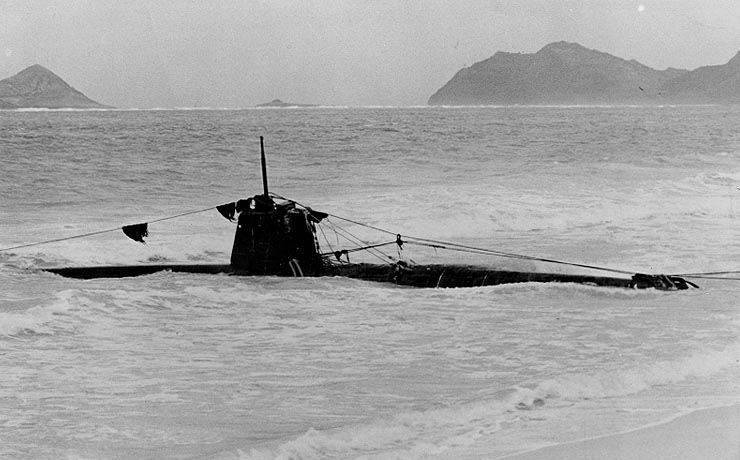
Submarine type "A" №19 on the water. Wikimedia Commons Photos
With his proposal, the officer appealed to the command of the Imperial fleet. The admirals were interested in the original idea, which made it possible to ensure a sufficiently high shock potential of the relevant units without the need to build full-fledged ships or submarines. K. Kisimoto received permission to develop a new project. He was appointed chief designer.
The first draft of the project was developed by the end of 1932. After making some changes, construction of the first prototypes began next year. Two experienced ultra small submarines received the special designation "A-Hotek" ("Target Boats of Type A"). This name came from considerations of secrecy. The enemy, even with good intelligence, was not supposed to learn about the newest project, which could significantly affect the power of the Japanese fleet. The construction of the first two Target Boats, according to different sources, was completed at the end of 1933 or at the beginning of 34.
Seeing the main features of the main types of serial submarines, Kisimoto put the question of speed at the forefront. Promising ultra-small submarines had to not only secretly approach the target, but also do it quickly. This requirement affected the appearance of the first two prototypes. These vehicles were an enlarged torpedo. The device with a length of about 20 m with a cylindrical body with a diameter of the order of 1,8 m had no chopping or other protruding parts. The robust housing was assembled from 8-mm steel, the lightweight body was made from sheets with a thickness of 1,2 mm. This design allowed to dive to a depth of 100 m. The used power unit based on the electric motor during the tests allowed to develop the speed of the 23,85 node.
Tests of the first two prototypes showed that the original idea of Captain Kisimoto has the right to life and should be developed. Nevertheless, to create a fully-fledged, efficient ultra-small submarine, some changes needed to be made to the project. It was decided to change the design of the hull, adjust the composition of the power plant and modify some other components and assemblies. The result of such changes was to be a reduction in the size and weight of the structure, as well as a noticeable decrease in the maximum travel speed. However, in this case, the new equipment should have high enough characteristics, and the reduction in speed was considered an acceptable price for the possibility of fully performing a combat task.
Known curious story, which began some time after the first tests. In the documents, the ultra-small submarines, which were supposed to be carriers of torpedoes, were called moving targets. Over time, information about some mysterious target boats reached the command of the air force, which became interested in this technique. For some time, the fleet command had to "fight off" from the Air Force, without disclosing the details of a secret project. As a result, the fleet and specialists were able to continue their work without wasting time on potential customers who had suddenly emerged.
A new version of the project, developed according to test results, received the designation "Ko-Hötek." At the same time, an additional designation with the letter “A” has been preserved. An updated version of the project later received approval, after which the serial construction of new ultra-small submarines began. The order of the fleet implied the delivery of fifty submarines. For various reasons, the construction of new equipment was delayed, because of which the fleet was able to begin training crews for the Ko-Hyotek only in the spring of 1941.
The design of the submarine type "A"
Serial submarines of type "A" had similar dimensions and displacement, but differed in some design features. As serial production introduced some new components and assemblies. The submersible displacement of all submarines of this type reached 47 t. The total length of the boat reached 23,9 m, the width reached 1,8 m. The height of the submarine, taking into account the cabin, was 3 m.
The submarine "A" was built according to the one-and-a-half scheme. Thus, the middle and aft parts of the hull were formed by a solid hull made of relatively thick steel. The bow of the hull and the cabin, which contained the sliding devices, in turn, were less durable and formed a non-sealed volume. Inside the robust hull there were several leaky bulkheads that divided the total volume into separate compartments.
The project of Captain Kisimoto meant the use of a curious arrangement of the internal volumes of the hull, to some extent resembling the layout of full submarines. In the nose there were two torpedo tubes located one above the other. Around the vehicles were placed two ballast tanks, valves for water intake and discharge, as well as a sealed electric pump.
Directly behind the torpedo tubes was a solid hull, which housed the crew and various units of the power plant, including batteries. In front of the hull were 136 batteries and another ballast tank. Behind them was located the central post with the jobs of two crew members. Provided a complete set of instruments for monitoring the operation of systems and controls, as well as a retractable periscope to monitor the environment.
Behind the crew were still 56 batteries. In addition, a special balancing weight of 406 kg was in the aft battery compartment. Its presence was determined by the ratio of the weight of the whole structure and ammunition. As the torpedoes were used, the submarine was supposed to “sink” aft. For this reason, in the central part of the hull, with a shift to the stern, there was a movable counterweight. On the way to the target, with both torpedoes, the cargo had to be in the rearmost position. After firing the first torpedo, it should be moved to the middle position, after launching the second one - to the extreme front.
In the aft compartment of the robust hull placed an electric motor with power 600 hp He rotated one propeller shaft, which set in motion two coaxial screws. Propellers were located behind the conical aft end of the hull, inside the annular casing. Two pairs of steering wheels were located in front of the screws, inside the special fencing.
On the outer surface of the case was located a set of special equipment. So, to protect the head of the torpedoes, protruding from the vehicles, there was a special openwork design. Some units, such as a periscope, a radio station antenna, and a snorkel for venting manned space, were located inside the wheelhouse. In the course of serial production, A-type submarines received equipment for overcoming anti-submarine networks and other obstacles. So, in the forward part of the hull, above the torpedo tubes, a small serrated saw appeared, designed for cutting barriers. The second such saw was located on the front of the cabin. Both saws were connected by a cable, designed to lead barriers to the top. On top of the wheelhouse, special arcs appeared to divert obstacles. Another cable connected the aft part of the cabin with fencing rudders and screws.
Initially it was assumed that the ultra-small submarines of the A-Hotek and Ko-Hyotek projects would carry two torpedoes of a caliber 533 mm each. However, in this case, the submarines were obtained too large and could not achieve the required characteristics. It was decided to reduce the caliber of torpedo tubes to 450 mm. The main weapons new submarines were to become torpedoes "Type 97". This weapon had a length of 5,6 m, weighed 980 kg and carried a 350-kg warhead. Torpedoes of this type were equipped with an engine that runs on kerosene and oxygen, which allowed them to reach speeds of up to 45 nodes and travel up to 5-5,5 km.
The crew of the submarine type "A" consisted of two people. They were located in the middle part of the body and had to monitor the work of various systems, search for targets and conduct an attack. The crew had several different types of compasses and other navigation equipment, a set of control instruments, and controls. The crew fully controlled the operation of the engine and other systems. To observe the situation, it was necessary to use a retractable periscope and a hydrophone. The receiving elements of the latter were in the fore and aft parts of the hull. Provision was made for the explosive charge to self-destruct the submarine. In order for the equipment not to get the enemy, the crew had to destroy it. According to some reports, the volume of the habitable compartment and the available cylinders with compressed air allowed the crew to be under water for 12 hours. After that, due to the decrease in oxygen concentration, it was necessary to float to the surface and ventilate the boat. For access to the central compartment was intended hatch, put into the wheelhouse.
As part of the electric system of the submarine type "A" there was a 192 battery cell. Such a number of batteries allowed the electric motor to provide the necessary energy and thus allowed to develop high speed. When moving on the surface, ultra-small submarines accelerated to 23 nodes. Underwater, the maximum speed was 19 nodes. The maximum cruising range per battery charge reached 100 nautical miles. To do this, it was necessary to save battery power while moving under water at a node's 2 speed. On 6 nodes, the cruising range was reduced to 80 miles. The maximum speed quickly discharged the batteries: it was possible to go through only 18 miles. A characteristic disadvantage of the used power plant was the absence of a generator. Because of this, the recharge of batteries could be carried out only on the base or on the carrier ship, which imposed certain restrictions on the flexibility of the use of submarines.
The strength of the Ko-Hötek submarine hull, according to various sources, made it possible to dive to a depth of 100 m. According to calculations, it was possible to dive and to a great depth, but in the 180-200 m range, the destruction of a solid hull could begin. Other sources mention a working depth of no more than 30 m. Anyway, the characteristics of the robust hull of new submarines allowed to operate covertly. During the tests, it turned out that for an emergency dive, in the event that an adversary detected an A-type submarine, it took no more than 5-7 seconds.
Boat production and diving training
The order of the command of the Imperial fleet implied the supply of 50 serial submarines of the new model. Japanese shipbuilders used a curious, but strange system for designating serial equipment. Ultra-small Type A submarines received serial numbers, which, however, were not used anywhere else. So, in most sources there is no definite connection between the serial number and the operation. In such cases, small-sized submarines are designated by the name of the carrier, which seriously complicates tracking their destinies. Also known about the existence of the designation, consisting of the index "Xa" and the serial number.
In the spring of 1941, the first training unit appeared, the purpose of which was to train future submariners-saboteurs. T.N. "Base-2" was built on Ourazaki Island. The first group of future pilots of Type A submarines consisted of an 24 man. Young officers studied the material part, mastered the management of new equipment and trained to carry out attacks. During the training, the first crews were not without problems. It is known about several accidents, and also erroneous attacks of auxiliary boats, which were accepted by crews of boats for training purposes. Nevertheless, the "Base-2" coped with its task, so that by December 41-th in the fleet of Japan there were several combat-ready submarines of a new type.
Pearl Harbor Attack
According to reports, the 7 of December 1941, the five A-type submarines, were to participate in the attack for the first time. Their goal was American ships based on Pearl Harbor. It was assumed that the crews would secretly enter the harbor and attack enemy ships. For the delivery of ultra-small submarines to the area of operation, the existing submarines that received some new equipment for the transportation of special equipment were used.
The first experience of the use of submarines "A" can not be called successful. The submarine with the serial number 18 could not reach the line of attack. She was seriously damaged by a sea mine (according to other sources, by a depth bomb), after which the crew decided to flee. The submarine, together with both torpedoes, went to the bottom. In the summer of 1960, it was discovered by divers. Soon the submarine was lifted and sent for repair. Since 1962, submarine №18 is located in the museum of the Naval Academy in Etajima (Japan).
The submarine №19 became a museum exhibit before, because it didn’t have to lie at the bottom for almost two decades. "X-19" was discovered by the Americans, after which it was forced to surrender. Officer Kazuo Sakamaki was captured, his partner was killed. The boat without serious damage was soon delivered to the United States, where it was carefully studied, and then transferred to propagandists. Until the end of the war, this submarine was an exhibit of a mobile museum, agitating the population to buy military bonds. Now the boat №19 is in the National Museum of the Pacific War, Fredericksburg (pc. Texas).
Submarine No.20 was detected by the destroyer USS Ward (DD-139) outside the harbor with the main US Navy forces. She was attacked by depth charges and sunk. The exact location of the flooding of the Japanese submarine was established only in the 2002 year, when it was discovered by divers.
The exact fate of the submarine №16 unknown. In the course of several studies, it was found that this submarine was likely to have been flooded by its own crew at the exit from the Pearl Harbor harbor. According to some reports, the crew managed to enter the harbor and release both torpedoes on American ships. One of the targets for the X-16 could be the battleship USS Oklahoma (BB-37). After the attack, the boat tried to leave, but for some reason the crew was forced to leave it. The basis for the assumption about the attack of the battleship are empty torpedo tubes on the detected boat, as well as one of the photographs taken by Japanese pilots. There are visible splashes above the starting point of one of the torpedoes aimed at American ships. It cannot be ruled out that the work of the submarine was the cause of the spray.
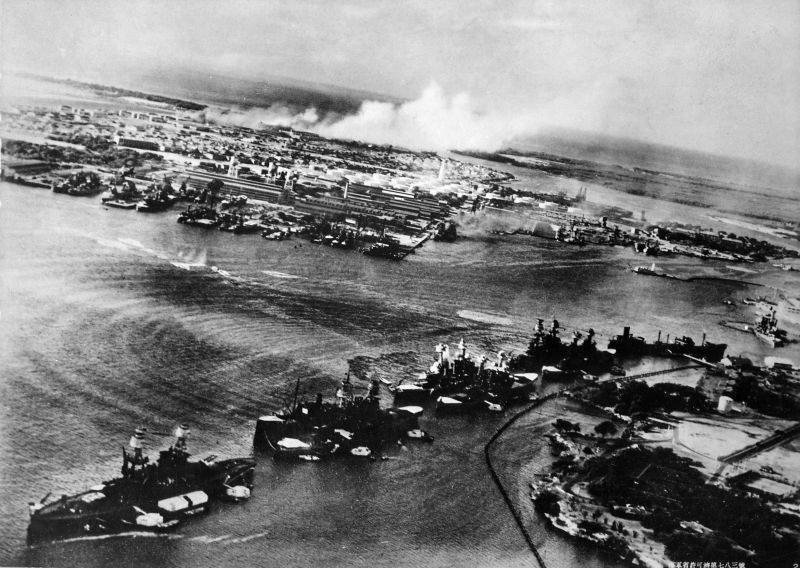
Torpedoing the battleship "Oklahoma", in which the submarine number XXUMX could participate. At the beginning of the torpedo trajectory, splashes are visible, which may indicate the presence of a submarine. Photo of Wikimedia Commons
There is reliable information about the combat work of the submarine with a serial number 22. She successfully broke into the harbor and fired her torpedoes on two American ships. The targets of this submarine were the hydroavian carrier USS Curtiss (AV-4) and the destroyer USS Monaghan (DD-354). Torpedoes passed by targets and hit the coastal structures. Finding themselves, the Japanese crew was attacked by the American destroyer. The submarine was damaged and sank. Later, during the construction of new berthing facilities for submarines at the Pearl Harbor base, the remains of the X-22 submarine along with the ground were used as material for one of the moles.
During the attack on Pearl Harbor, the connection of ultra-small A-class submarines suffered heavy losses. All five submarines were lost, only one submariner survived. Despite the losses, the crews of submarines could not cause appreciable damage to the enemy fleet. As a result, all the losses of the American fleet were recorded by pilots. However, it should be noted that the battleship "Oklahoma" as a result of the attack of the torpedo bombers and, possibly, the ultra-small submarine, was seriously damaged and sank. In the autumn of 1943, it was lifted and examined, but decided not to repair it. Thus, it is possible that type A submarines could still cause some damage to the enemy.
Attack in Sydney Bay
Due to the loss of all the used submarines in the attack on Pearl Harbor, it was decided to take care of such equipment and not to send it to the tasks, until the main issues of the tactics of application are resolved. Because of this, Type A submarines were not used in combat until the end of May 1942.
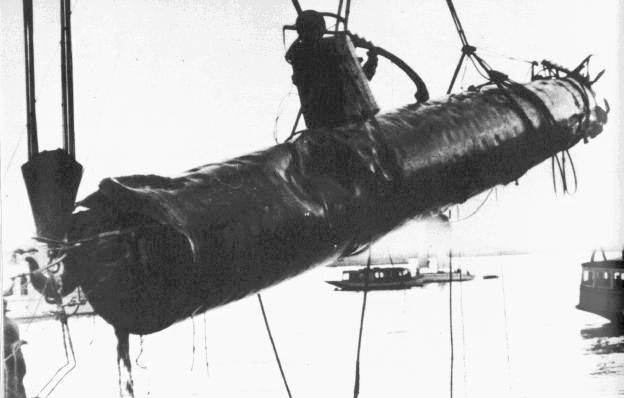
Lifting the submarine №21 in Sydney Bay. Photo Photo Wikimedia Commons
In late May, several Japanese submarines with ultra-small submarines on the decks arrived at the bay of Sydney (Australia). Aerial reconnaissance of the Japanese showed that a large number of ships in Australia, Great Britain and the United States are in the bay. It was decided to attack them. On the night of May 30, ultra-small submarines were brought to the minimum possible distance from the bay and uncoupled. Then they worked themselves, and, it should be noted, again showed no outstanding results.
Approaches to the bay of Sydney were equipped with systems for detecting ships and submarines. To some extent, this technique helped the defending side, although the response to the signals was not always adequate. So, the submarine "X-14" was found around eight in the evening, but the anti-submarine defense took no action. The signal was considered false because at this time there were a large number of ships and vessels in the sensor area. Shortly thereafter, the Japanese boat collided with an enemy ship, dropped back and entangled in the anti-submarine network. Australian patrol ships HMAS Yarroma and HMAS Lolita launched an attack, but failed to hit the target. Soon after the discovery, the Japanese submariners undermined the charge for self-destruction and died along with the boat.
About ten o'clock in the evening the submarine No. XXUMX entered the bay. Soon she was discovered and began to persecute. The crew managed to escape and wait until the defending party stopped searching. Around 24: 0 Japanese released two torpedoes on the cruiser USS Chicago, but missed. Both torpedoes hit the shore. In this case, the explosion of one of them damaged the ship HMAS Kuttabul, which soon sank. During the 30 explosion, the sailor died, another 21 was injured. After this attack, the submarine №10 left the bay and went to the point of meeting with the carrier. However, the meeting did not take place. The boat went missing. It was discovered only in the 24 year.
The last in the bay entered the submarine "X-21". She was discovered, but soon lost. The crew was able to lie low and waited a few hours. Only after three o'clock in the morning the Japanese tried again to accomplish the combat mission. However, around 3: 50, the submarine was spotted and attacked. Several depth bomb attacks resulted in serious damage to the submarine. Seeing no exit, the submariners blew up their submarine.
During the attack in the bay of Sydney, Japan lost all three used super-small A-type submarines. All crews died. Submariners managed to sink only one ship and inflict some damage on shore facilities. Both submarines, flooded in the bay, in the summer 42-th raised to the surface. Of these, one model was assembled, which was further demonstrated to the population as an example of victory over the enemy.
Attack at the port of Diego Juarez
During the attack in the bay of Sydney, the Imperial fleet of Japan fought at Madagascar. In this operation, ultra-small A-type submarines were also involved. This time only two submarines participated in the battle. The I-16 and I-20 submarines delivered two ultra-small submarines to the port of Diego-Suarez. One of the submarines fired both torpedoes that hit the battleship HMS Ramillies and the tanker British Loyality. The tanker caught fire and sank. The battleship remained afloat and was soon sent in for repair, after which it continued service. Having found herself, the submarine became a target for the enemy. She was destroyed by depth charges. The body of one of the Japanese submariners the next day washed ashore.
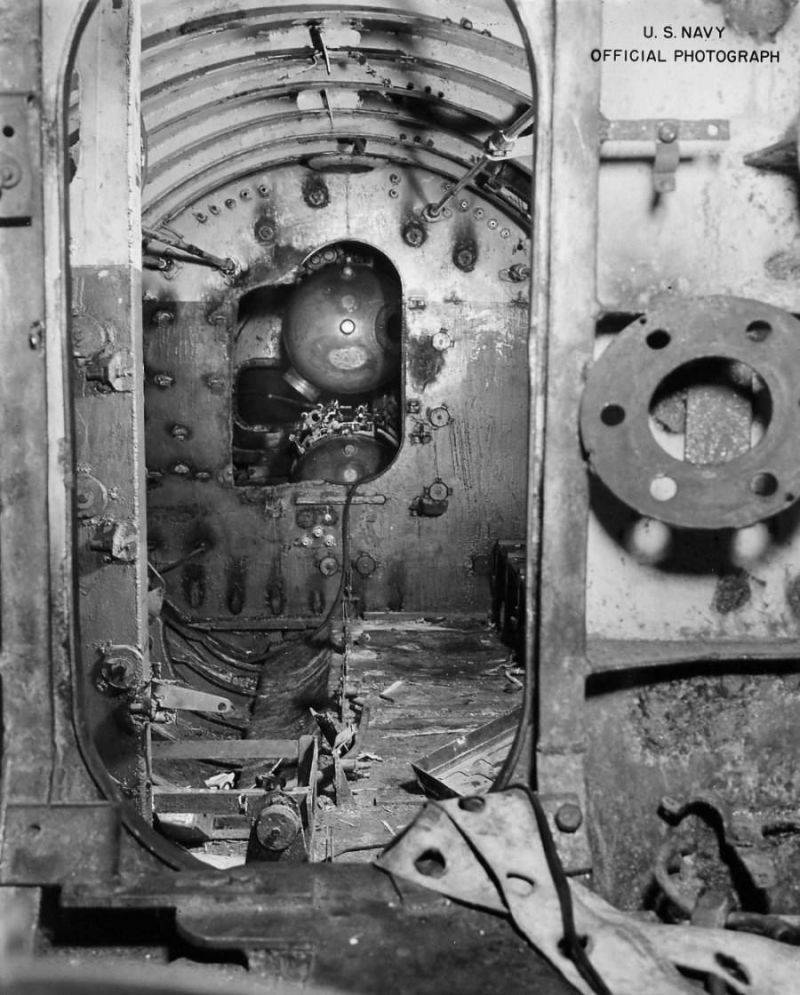
The interior of the durable hull submarine №19. View through the hatch in the bulkhead between the central post and the battery compartment. In the background, torpedo tubes, visible through a hole in the bulkhead. Batteries, etc. equipment dismantled. Photo Navsource.org
Information about the success of the submarine, launched with I-20, is missing. Nevertheless, it is known that her crew got ashore and tried to escape in the woods. The Japanese discovered themselves while trying to establish contact with the local population. A few days later they were found by the British marines and died in battle.
Results of the project
Ultra-small "A" submarines proved to be in battle as not the most reliable and effective means of performing covert attacks. In just three operations, the Japanese fleet lost 10 10 submarines that were sent to the mission. The number of surviving submariners could literally be counted on the fingers, and only one officer lived to the end of the war. All this did not suit the admirals, because of what they ordered to rework the project and improve it. It was necessary to change the mass of the features of the basic project in order to improve the characteristics and provide the required combat effectiveness. The result of this order was the emergence of a new project, designated by the letter “B”.
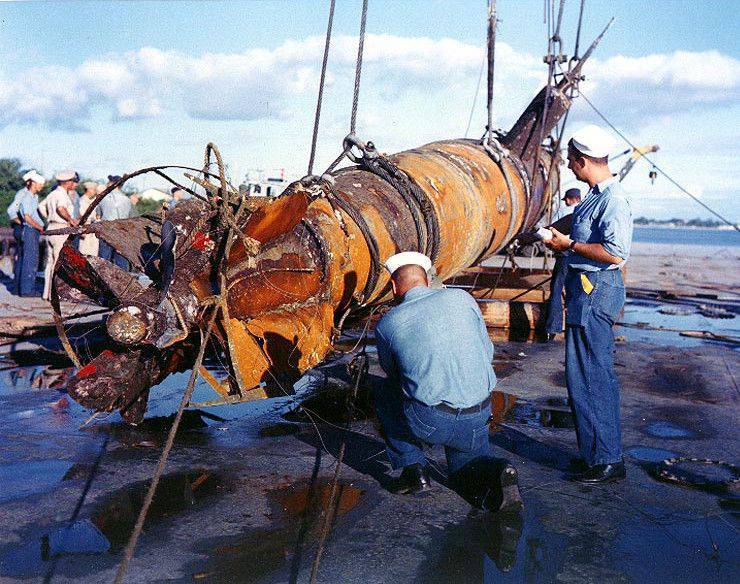
Lift of the submarine №18 in the harbor of Pearl Harbor, 1960. Photo by Wikimedia Commons
Project “B” differed from the base “A” with some design features, used aggregates, etc. Seeing the advantages of the new project over the old one, the fleet ordered the construction of new serial submarines. Moreover, the last five submarines of type “A” were completed according to the updated project. It was expected that this would allow the Imperial Navy to get more modern submarines with high performance. Even after the failures off the coast of Sydney and Madagascar, the Japanese command kept hoping to begin full-fledged exploitation of the new promising technology.
In anticipation of a sufficient number of type “B” submarines, the obsolete model technique was used to train future submariners. This allowed most of the submarines "A" to survive until the end of the war. Some of the remaining boats were destroyed by raids aviation, but by the fall of the 45th at the bases there was a noticeable amount of submarines. After signing the act of surrender, they all went to the United States. American experts studied this technique, and then sent it to museums or for re-melting. Several instances of type “A” submarines survived to this day. They are in several museums in Japan and the United States.
On the materials of the sites:
http://modelist-konstruktor.com/
http://vokrugsveta.ru/
http://environment.nsw.gov.au/
http://navsource.org/
http://archaehistoria.org/
http://combinedfleet.com/
More photos of different type A submarines: http://navsource.org/archives/08/08456.htm
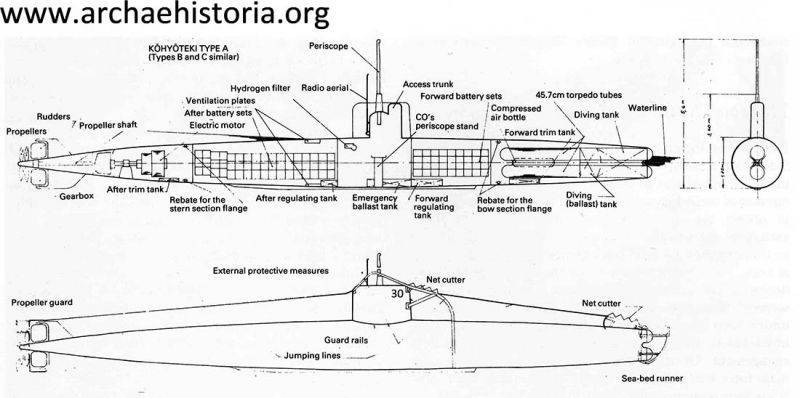

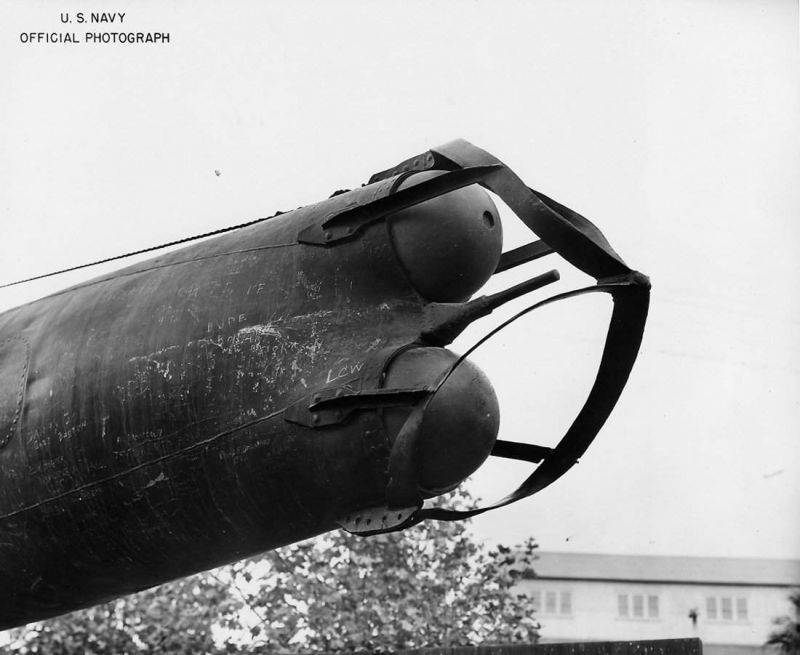
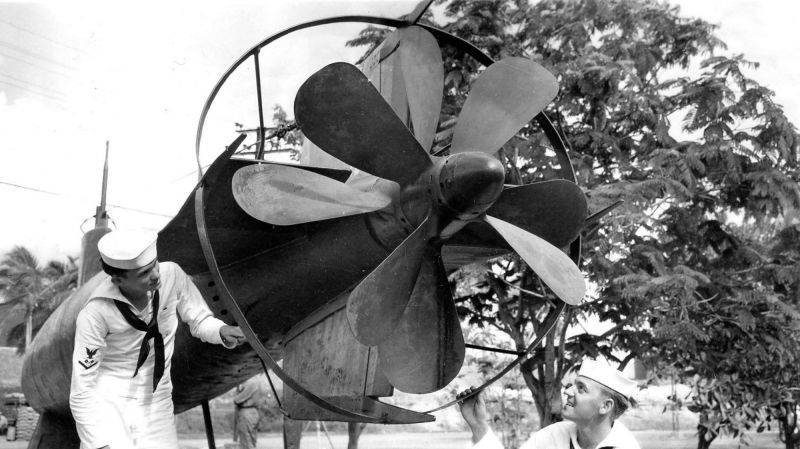
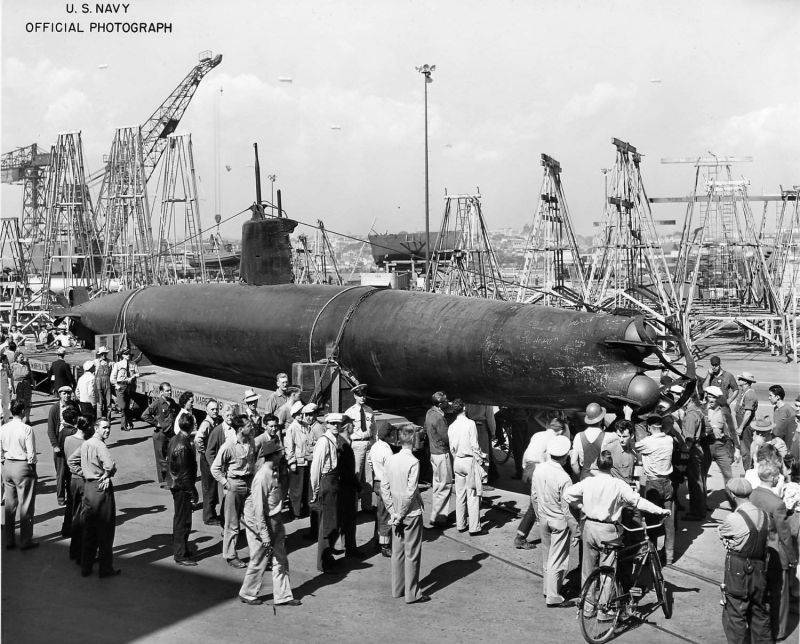
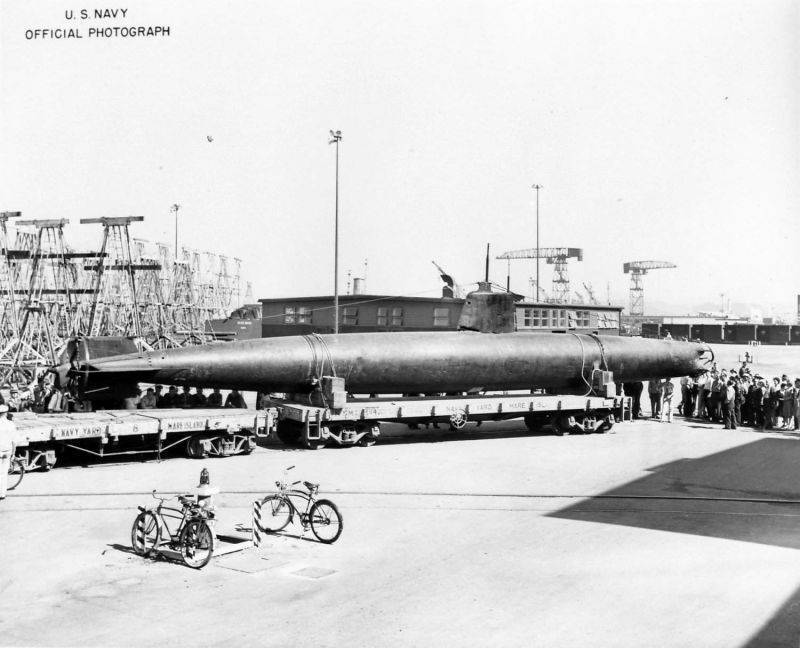
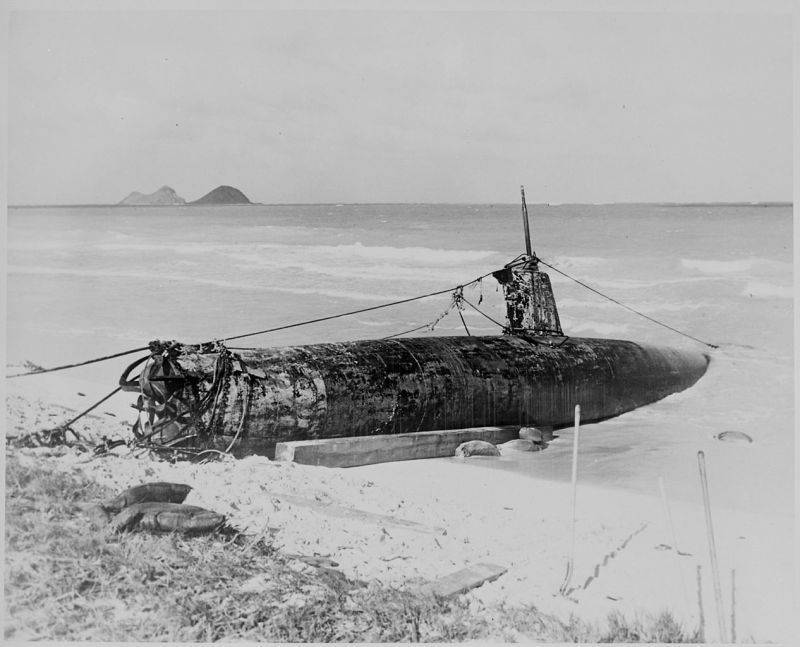
Information